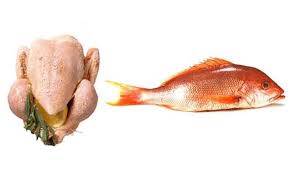Chicken Versus Fish: Which is Healthier?
When it comes to choosing a protein source, chicken often stands out as a popular option. However, the health implications of consuming chicken can vary depending on the type and preparation method. In this article, we’ll explore different forms of chicken, compare them to other protein sources, and help you determine which option may be healthier for your diet.
Types of Chicken
1. Skinless Chicken Breast: Often considered the healthiest option, skinless chicken breast is low in fat and high in protein, making it a favorite among fitness enthusiasts. A 3.5-ounce (100-gram) serving contains approximately 165 calories, 31 grams of protein, and 3.6 grams of fat.
2. Chicken Thighs: While darker meat, such as chicken thighs, is higher in fat than breast meat, it also offers more flavor and juiciness. A 3.5-ounce serving of cooked chicken thighs contains about 209 calories, 26 grams of protein, and 10.9 grams of fat. The higher fat content can be beneficial for those following a higher-fat diet.
3. Chicken Wings: Typically served fried and often slathered in sauces, chicken wings are less healthy due to their higher calorie count and unhealthy fats. A serving of fried chicken wings can contain around 430 calories and 30 grams of fat.
4. Organic and Free-Range Chicken: These options are often seen as healthier due to their production methods, which prioritize animal welfare and often result in meat that is free from antibiotics and hormones. Some studies suggest that free-range chicken may have higher omega-3 fatty acid levels.
5. Processed Chicken Products: Items like chicken nuggets, tenders, or deli meats are usually high in sodium, preservatives, and unhealthy fats, making them less healthy than whole chicken cuts.
Comparing Chicken to Other Proteins
When assessing chicken’s health benefits, it’s essential to compare it with other protein sources.
- Turkey: Similar to chicken in terms of nutritional content, turkey is often leaner and has lower fat levels. Skinless turkey breast is an excellent alternative for those looking for lower fat.
- Fish: Fatty fish like salmon are rich in omega-3 fatty acids, which promote heart health. While chicken is a good protein source, fish provides essential fats that chicken lacks.
- Red Meat: Beef and pork can be higher in saturated fats and cholesterol compared to chicken. Lean cuts can be a healthy option, but frequent consumption of red meat has been linked to health issues such as heart disease.
- Plant-Based Proteins: Options like lentils, chickpeas, and tofu offer health benefits without the saturated fats found in animal proteins. They are high in fiber, which promotes digestion and can aid in weight management.
Health Considerations
1. Preparation Methods: How chicken is prepared significantly affects its healthfulness. Grilling, baking, or steaming chicken retains its nutritional benefits, while frying or breading adds unhealthy fats and calories.
2. Portion Control: Moderation is key. Eating large portions of even healthy chicken can contribute to excessive calorie intake.
3. Overall Diet: Chicken should be part of a balanced diet that includes a variety of protein sources, fruits, vegetables, and whole grains. This diversity ensures you receive a range of nutrients.
Conclusion
Chicken can be a healthy protein choice, particularly when opting for lean cuts like skinless breast and using healthy cooking methods. However, comparing it with other protein sources reveals that there are both benefits and drawbacks. Ultimately, the healthiest option depends on individual dietary needs, preferences, and overall lifestyle. For a balanced approach, consider incorporating a mix of protein sources into your diet, ensuring you meet your nutritional goals while enjoying a variety of flavors and textures.


